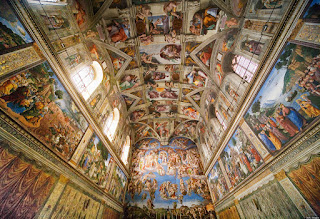 |
| Sistine Chapel |
Designed by architects Baccio Pontelli and Giovanni de
Dolci, the Sistine Chapel finished construction in 1481 in honor of pope Sixtus
IV. Designed in the renaissance style of architecture, Its famous feature is
the frescoes by Michelangelo.
Following the Gothic period of architecture. To the
Italians, gothic architecture was considered to be uncivilized and brutish,
leading to the term “dark ages”. During this time, Italians began to view their
history differently. As opposed to the divine continuum, Italians started to
view their history as periods of great achievement. They believed they were at
the start of a new age. [1]
Their architecture, as opposed to point skyward like gothic
architecture, took elements form ancient greek and roman architecture. Emphasis
was put on a balance of vertical and horizontal elements, human proportions.
This new architecture was visually clear and rationally organized. Designed to
fulfill the needs of man, not just the church.[1]
The Sistine Chapel was designed in the Renaissance style of
Architecture with an emphasis on horizontality. The building is rectangular in
plan, supported by large, load bearing walls. Six, large windows line the north
and south sides, equally divided by pilasters.
 |
| Chapel Fresco Painting |
The interior is infamous for the fresco painting. Painted by
Michelangelo, the project took four years to complete. The ceiling depicts
scenes from the Book of Genesis. The
most famous of which is the creation of Adam. The ceiling also depicts notable
families from the bible. The manner in which the painting was done is known
fresco. The painting was done on top of wet plaster, allowing the paint to
penetrate the plaster. Once dried, the paint hardens with the plaster, becoming
part of it. Recently, the ceiling has undergone a restoration, removing dirt
and grime, restoring the natural luster.
The exterior façade is made of brick, standing about 68’
tall. The emphasis is on the horizontal. The only vertical element are the
clerestory windows. This adds to the belief that buildings did not need to
reach the heavens. Giving the chapel a lower profile and human proportions
reflected men.
Following the strict rules of form, order, and geometric
proportions, the Sistine chapel is a prime example of high renaissance
architecture.
[1] Roth Leland M. and Amanda C. Roth Clark, Understanding
Architecutre Its Elements, History, and Meaning, Third Edition Westview
Press 2014. P.365
No comments:
Post a Comment